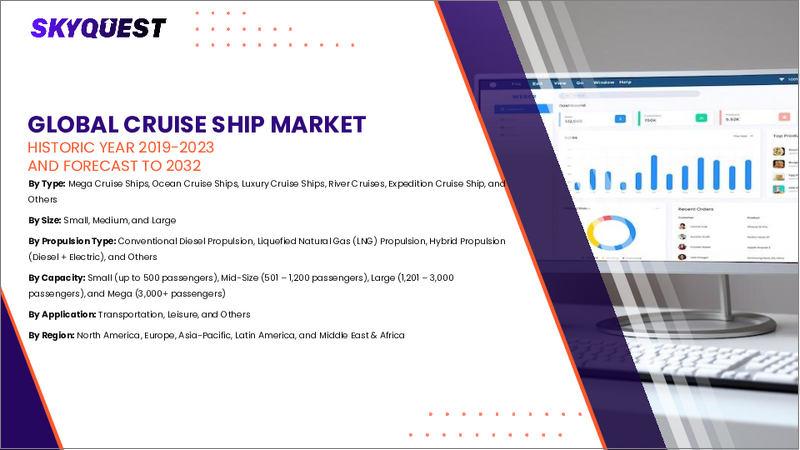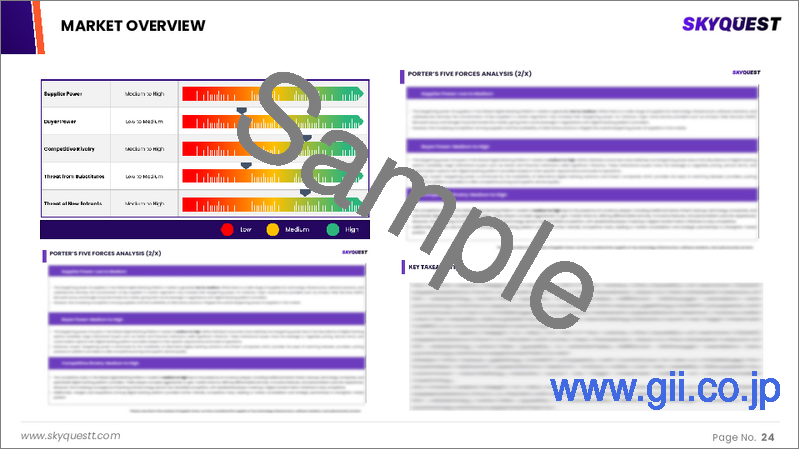|
|
市場調査レポート
商品コード
1796492
クルーズ船の市場規模、シェア、成長分析:タイプ別、用途別、エンドユーザー別、地域別 - 産業予測、2025~2032年Cruise Ship Market Size, Share, and Growth Analysis, By Type (Ocean Cruise Ships, Luxury Cruise Ships), By Application (Transportation, Leisure), By End User, By Region - Industry Forecast 2025-2032 |
||||||
|
|||||||
| クルーズ船の市場規模、シェア、成長分析:タイプ別、用途別、エンドユーザー別、地域別 - 産業予測、2025~2032年 |
|
出版日: 2025年08月18日
発行: SkyQuest
ページ情報: 英文 185 Pages
納期: 3~5営業日
|
全表示
- 概要
- 目次
世界のクルーズ船の市場規模は2023年に88億米ドルと評価され、2024年の95億7,000万米ドルから2032年には187億1,000万米ドルに成長し、予測期間(2025~2032年)のCAGRは11.5%で成長する見通しです。
世界のクルーズ船市場は、消費者の嗜好の変化、政府の支援政策、継続的な技術の進歩によって大きな成長を遂げています。スマートツーリズムと持続可能な沿岸開発を促進するために、港湾インフラを強化し、革新的なクルーズ技術を活用することに顕著な重点が置かれています。業界は、運航効率の向上だけでなく、環境への責任も重視した数々の進歩を受け入れてきました。エネルギー効率の高い代替燃料船の推進は、業界の持続可能性へのコミットメントの証であり、クルーズ体験全体を向上させながら環境への影響を軽減するのに役立っています。このような力学が進化するにつれて、旅行や観光におけるより広範な動向と一致しながら、クルーズ業界の将来を形作ることになりそうです。
目次
イントロダクション
- 調査の目的
- 調査範囲
- 定義
調査手法
- 情報調達
- 二次と一次データの方法
- 市場規模予測
- 市場の前提条件と制限
エグゼクティブサマリー
- 世界市場の展望
- 供給と需要の動向分析
- セグメント別機会分析
市場力学と展望
- 市場概要
- 市場規模
- 市場力学
- 促進要因と機会
- 抑制要因と課題
- ポーターの分析
主な市場の考察
- 重要成功要因
- 競合の程度
- 主な投資機会
- 市場エコシステム
- 市場の魅力指数(2024年)
- PESTEL分析
- マクロ経済指標
- バリューチェーン分析
- 価格分析
- ケーススタディ
クルーズ船の市場規模:タイプ別、CAGR(2025~2032年)
- 市場概要
- 海洋クルーズ船
- 豪華クルーズ船
- エクスペディションクルーズ船
- リバークルーズ船
- メガクルーズ船
クルーズ船の市場規模:用途別、CAGR(2025~2032年)
- 市場概要
- 交通
- レジャー
- エンターテインメント
クルーズ船の市場規模:エンドユーザー別、CAGR(2025~2032年)
- 市場概要
- 商業事業者
- 個人所有者
- 政府機関
クルーズ船の市場規模:地域別、CAGR(2025~2032年)
- 北米
- 米国
- カナダ
- 欧州
- ドイツ
- スペイン
- フランス
- 英国
- イタリア
- その他欧州地域
- アジア太平洋地域
- 中国
- インド
- 日本
- 韓国
- その他アジア太平洋地域
- ラテンアメリカ
- ブラジル
- その他ラテンアメリカ地域
- 中東・アフリカ
- GCC諸国
- 南アフリカ
- その他中東・アフリカ
競合情報
- 上位5社の比較
- 主要企業の市場ポジショニング(2024年)
- 主な市場企業が採用した戦略
- 最近の市場動向
- 企業の市場シェア分析(2024年)
- 主要企業の企業プロファイル
- 企業の詳細
- 製品ポートフォリオ分析
- 企業のセグメント別シェア分析
- 収益の前年比比較(2022~2024年)
主要企業プロファイル
- Carnival Corporation & Plc
- Royal Caribbean Group
- MSC Cruises S.A.
- Norwegian Cruise Line Holdings Ltd.
- Disney Cruise Line
- Genting Hong Kong Limited
- Fred. Olsen Cruise Lines
- Princess Cruises
- Celebrity Cruises
- TUI Cruises
- Adora Cruises
- Costa Cruises
- Holland America Line
- P&O Cruises
- Cunard Line
結論と提言
Global Cruise Ship Market size was valued at USD 8.8 Billion in 2023 and is poised to grow from USD 9.57 Billion in 2024 to USD 18.71 Billion by 2032, growing at a CAGR of 11.5% in the forecast period (2025-2032).
The global cruise ship market is experiencing significant growth driven by shifts in consumer preferences, supportive government policies, and ongoing technological advancements. There is a remarkable emphasis on enhancing port infrastructure and leveraging innovative cruise technologies to promote smart tourism and sustainable coastal development. The industry has embraced numerous advancements, which have not only improved operational efficiency but also emphasized environmental responsibility. The push for energy-efficient and alternative-fueled vessels is a testament to the industry's commitment to sustainability, helping to mitigate environmental impacts while enhancing the overall cruising experience. As these dynamics evolve, they are likely to shape the future of the cruise industry, aligning with broader trends in travel and tourism.
Top-down and bottom-up approaches were used to estimate and validate the size of the Global Cruise Ship market and to estimate the size of various other dependent submarkets. The research methodology used to estimate the market size includes the following details: The key players in the market were identified through secondary research, and their market shares in the respective regions were determined through primary and secondary research. This entire procedure includes the study of the annual and financial reports of the top market players and extensive interviews for key insights from industry leaders such as CEOs, VPs, directors, and marketing executives. All percentage shares split, and breakdowns were determined using secondary sources and verified through Primary sources. All possible parameters that affect the markets covered in this research study have been accounted for, viewed in extensive detail, verified through primary research, and analyzed to get the final quantitative and qualitative data.
Global Cruise Ship Market Segments Analysis
The global cruise ship market is segmented based on type, application, end user, and region. By type, the market is categorized into ocean cruise ships, luxury cruise ships, expedition cruise ships, river cruise ships, and mega cruise ships. In terms of application, it is divided into transportation, leisure, and entertainment. Based on end user, the market is classified into commercial operators, private owners, and government entities. Regionally, it is analyzed across North America, Europe, Asia-Pacific, Latin America, and the Middle East & Africa.
Driver of the Global Cruise Ship Market
The growth of the Global Cruise Ship market is largely fueled by the rising middle class in regions such as Asia-Pacific, Latin America, and parts of Europe, which drives the demand for both affordable and luxurious cruise experiences. As more individuals seek enjoyable and convenient leisure travel options, cruise lines are diversifying their offerings to cater to different budget levels. This strategic expansion not only broadens the appeal of cruise vacations but also plays a crucial role in enhancing market penetration in emerging economies. Consequently, the cruise industry is experiencing significant growth as it attracts a wider demographic of travelers seeking unique experiences.
Restraints in the Global Cruise Ship Market
The Global Cruise Ship market faces several restraints stemming from substantial financial commitments related to maintenance, crew management, fuel, food services, and onboard amenities. These considerable operating costs can significantly diminish profit margins, especially during economic downturns. Furthermore, the challenge of sustaining cost efficiency is exacerbated by stringent maritime regulations and increasing fuel prices, which collectively impact the overall revenue of the cruise ship industry. Such factors discourage smaller operators from either entering the market or expanding their business, ultimately limiting competition and innovation within the sector. As a result, the market grapples with constraints that hinder its growth potential.
Market Trends of the Global Cruise Ship Market
The Global Cruise Ship market is witnessing a significant trend toward eco-friendly and sustainable practices. Cruise lines are increasingly investing in innovative technologies such as advanced waste management systems, solar-assisted energy solutions, and liquefied natural gas (LNG)-powered vessels. This shift is driven not only by regulatory pressures but also by the growing demand from environmentally conscious travelers who prioritize sustainable tourism options. As the industry evolves, green innovation has become a central theme, reshaping operations and appealing to a broader demographic of eco-aware clientele. This commitment to sustainability represents a transformative movement within the cruise sector, setting the stage for a cleaner, greener future.
Table of Contents
Introduction
- Objectives of the Study
- Scope of the Report
- Definitions
Research Methodology
- Information Procurement
- Secondary & Primary Data Methods
- Market Size Estimation
- Market Assumptions & Limitations
Executive Summary
- Global Market Outlook
- Supply & Demand Trend Analysis
- Segmental Opportunity Analysis
Market Dynamics & Outlook
- Market Overview
- Market Size
- Market Dynamics
- Drivers & Opportunities
- Restraints & Challenges
- Porters Analysis
- Competitive rivalry
- Threat of substitute
- Bargaining power of buyers
- Threat of new entrants
- Bargaining power of suppliers
Key Market Insights
- Key Success Factors
- Degree of Competition
- Top Investment Pockets
- Market Ecosystem
- Market Attractiveness Index, 2024
- PESTEL Analysis
- Macro-Economic Indicators
- Value Chain Analysis
- Pricing Analysis
- Case Studies
Global Cruise Ship Market Size by Type & CAGR (2025-2032)
- Market Overview
- Ocean Cruise Ships
- Luxury Cruise Ships
- Expedition Cruise Ships
- River Cruise Ships
- Mega Cruise Ships
Global Cruise Ship Market Size by Application & CAGR (2025-2032)
- Market Overview
- Transportation
- Leisure
- Entertainment
Global Cruise Ship Market Size by End User & CAGR (2025-2032)
- Market Overview
- Commercial Operators
- Private Owners
- Government Entities
Global Cruise Ship Market Size & CAGR (2025-2032)
- North America (Type, Application, End User)
- US
- Canada
- Europe (Type, Application, End User)
- Germany
- Spain
- France
- UK
- Italy
- Rest of Europe
- Asia Pacific (Type, Application, End User)
- China
- India
- Japan
- South Korea
- Rest of Asia-Pacific
- Latin America (Type, Application, End User)
- Brazil
- Rest of Latin America
- Middle East & Africa (Type, Application, End User)
- GCC Countries
- South Africa
- Rest of Middle East & Africa
Competitive Intelligence
- Top 5 Player Comparison
- Market Positioning of Key Players, 2024
- Strategies Adopted by Key Market Players
- Recent Developments in the Market
- Company Market Share Analysis, 2024
- Company Profiles of All Key Players
- Company Details
- Product Portfolio Analysis
- Company's Segmental Share Analysis
- Revenue Y-O-Y Comparison (2022-2024)
Key Company Profiles
- Carnival Corporation & Plc
- Company Overview
- Business Segment Overview
- Financial Updates
- Key Developments
- Royal Caribbean Group
- Company Overview
- Business Segment Overview
- Financial Updates
- Key Developments
- MSC Cruises S.A.
- Company Overview
- Business Segment Overview
- Financial Updates
- Key Developments
- Norwegian Cruise Line Holdings Ltd.
- Company Overview
- Business Segment Overview
- Financial Updates
- Key Developments
- Disney Cruise Line
- Company Overview
- Business Segment Overview
- Financial Updates
- Key Developments
- Genting Hong Kong Limited
- Company Overview
- Business Segment Overview
- Financial Updates
- Key Developments
- Fred. Olsen Cruise Lines
- Company Overview
- Business Segment Overview
- Financial Updates
- Key Developments
- Princess Cruises
- Company Overview
- Business Segment Overview
- Financial Updates
- Key Developments
- Celebrity Cruises
- Company Overview
- Business Segment Overview
- Financial Updates
- Key Developments
- TUI Cruises
- Company Overview
- Business Segment Overview
- Financial Updates
- Key Developments
- Adora Cruises
- Company Overview
- Business Segment Overview
- Financial Updates
- Key Developments
- Costa Cruises
- Company Overview
- Business Segment Overview
- Financial Updates
- Key Developments
- Holland America Line
- Company Overview
- Business Segment Overview
- Financial Updates
- Key Developments
- P&O Cruises
- Company Overview
- Business Segment Overview
- Financial Updates
- Key Developments
- Cunard Line
- Company Overview
- Business Segment Overview
- Financial Updates
- Key Developments





